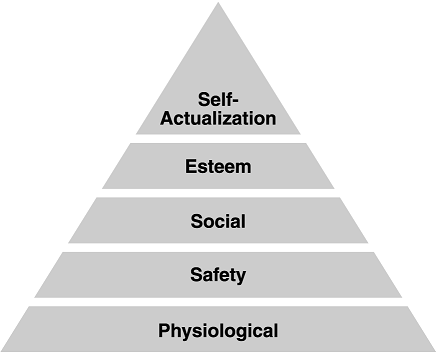For those of you who don’t know, Abraham Maslow published a paper in 1943 titled “A Theory of Human Motivation.” In this work he established a hierarchy of needs that he argued was fundamental to all humans. The structure of his hierarchy is often portrayed as a pyramid with the more basic needs making up the base and the less essential needs towards the top. The needs in order are:
- Physiological
- Safety
- Love/belonging (social)
- Esteem
- Self-actualization
Personification of Business
You may be asking yourself how in the world a personal hierarchy can apply to a business. Businesses are an outpouring of their founder and as such carry many traits found in the individual. If you look at any company, large or small, you can trace its origin back to a person or a small group of people. Additionally, the company was built to fulfill a need that others have, making it very much a relational entity. In short, you are your first business. I may explore this truth a bit more in future articles, but for now the above correlation is sufficient.
Physiological Needs of a Business
For the individual these are the literal requirements for survival; for the business this would consist of an audience, a need to fulfill, and a value proposition. If any one of these is removed a business will wither and die. The business is sustained through fulfilling the need of a group of people by posing its value proposition. Growth will come in the form of compensation.
Safety Needs of a Business
The safety needs of a business tie into how far away a company is from going bankrupt. This displacement is a function of how competitive the company’s value proposition is, how diversified its portfolio may be, and how much cash it has to weather unforeseen storms. The only threat to a business is its inability to turn a profit. So, anything that jeopardizes this would be in conflict with the safety needs.
Social Needs of a Business
Individuals realize love and belonging needs through friendship, intimacy, and family. A business is no different. Once a customer-supplier relationship is established through customer acquisition, the business must continue to invest into each customer in order to grow the relationship. A competitive advantage can bring new people to a business, but the relationship that is established is what will keep those people coming back and referring others. Said another way, the love and belonging needs would be the market’s acceptance and perception of the business as a member of their respective community.
Esteem Needs of a Business
For the individual, esteem needs speak to the desire to feel respected and to have a good self-image. For the business, the fulfillment of this need is made evident by expressed industry standing or awards. Awards and being number one in an industry may win over a few customers, but they are not required to turn a profit. This is why the esteem needs are further down the hierarchy. Having these fulfilled will help the business as an entity feel good about itself but are not required for survival. A company with a high collective self-esteem will cultivate a positive culture among its employees, which in turn will bring about more successful ventures.
Self-actualization Needs of a Business
Self-actualization is the fulfillment of one’s own potential. Companies that seek this fulfillment are the ones who so exceedingly meet a demand that they create new markets and innovations. Apple would be a prime example of self-actualization being fulfilled. In everything Apple has done, they have pushed the limits of how people create with technology. Steve Jobs directed the company towards excellence by helping people create in ways they could never achieve before. Consequently, the iMac, the iPod, the iPhone, and the iPad all played a big role in the introduction of new markets. The self-actualization need of a business is tied tightly to the man steering the ship. The CEO of a business will dictate a company’s direction, which may or may not be towards self-actualization. CEO Steve Jobs led Macintosh through each of its largest innovations, but when he left, it began to lose its way and market share. Upon his return, Macintosh quickly returned to its initial direction and to profitability.
Conclusion
As an entrepreneur or small business owner you would be wise to realize the organic nature of the business you conduct. Businesses are living entities with needs that, if not met, will perish. If nurtured, however, they can grow to unprecedented levels, reaching and affecting the lives of many. As an entrepreneur, I know that there are many things on your plate, but I would challenge you to filter through the noise and find the one thing that you know you can do exceedingly well. It will be in that focus that you find your true genius.
I have discussed another benefit to focusing your efforts in the article titled Successful Habits. In it I explore the ramifications of spreading yourself thin and the inefficiency of multitasking. When I learned this principle, my world changed, and everyone I have shared it with has also found it extremely helpful.

Leave a Reply